Getúlio Dornelles Vargas was a lawyer, politician and president of Brazil born in the city of São Borja (RS), on April 19, 1882 and died on August 24, 1954.
Vargas made his political career in Rio Grande do Sul and reached the presidency of the Republic in 1930.
He was the longest-serving president in all of Brazil's republican history.
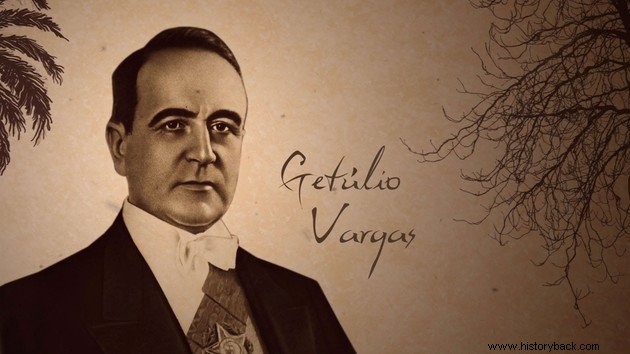
Vargas was elected state deputy in Rio Grande do Sul for the first time in 1909, being reelected several times.
He married his countryman, Darci Sarmanho Vargas (1914-1992) and they had five children. Three of them also became involved in politics, such as Alzira Vargas (1914-1992) who was Head of the Civil Cabinet of the Presidency of the Republic.
Getúlio Vargas became Minister of Finance in 1926, under Washington Luís. Then he was president (governor) of Rio Grande do Sul in 1928.
He reached the presidency in 1930, after the Revolution of 30. He remained in power first from 1930 to 1945, when he was deposed and returned through popular vote in 1950.
Four years later, pressured to resign, he would commit suicide.
Revolution of 30 and Getúlio Vargas
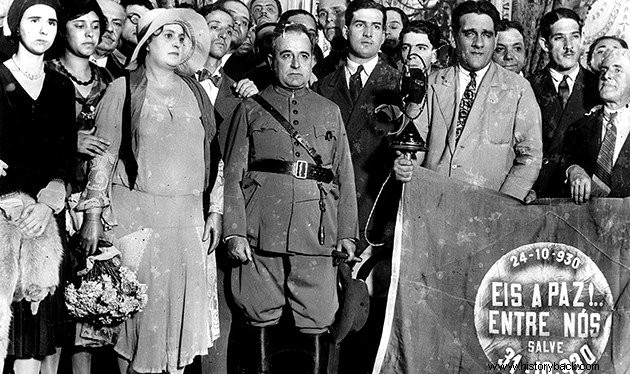
The so-called café au lait policy maintained strong ties with large landowners and power was shared between politicians in São Paulo and Minas Gerais.
Therefore, Vargas knew that he had little chance of winning the election when he was a candidate for the presidency of the Republic in 1930. When his vice president, João Pessoa, was assassinated, he led a coup against the power of those states.
Vargas led the Revolution of 1930, in which he deposed Washington Luís (1869-1957) and broke the cycle of political alternation between the coffee and livestock oligarchies, in a regime known as the governors' policy.
In this way, he won the presidency and remained there from 1930 to 1945.
Complement your study:
- Tenentism
- Old Republic
Provisional Government (1930-1934)
The provisional government of Getúlio Vargas was marked by political instability, as he showed signs that he would not call elections for President of the Republic.
The president tries to articulate with various sectors of society such as the Church and the most visible sign of this approach is the inauguration of Christ the Redeemer, in Rio de Janeiro, on October 12, 1931. He also won the support of women, approving, in 1932, the women's vote, but moves away from more progressive ideas.
Likewise, it creates the Ministry of Education and Culture, making primary education compulsory. On the other hand, he ends up with union freedom and invests in industries as a way to generate employment.
In the political field, Vargas replaces the former state governors with interventors who were the lieutenants who had participated in the Revolution of 1930.
Dissatisfied with these arbitrary measures taken by the president, the state of São Paulo decides to take up arms, in the episode known as the 1932 Revolution.
After Getúlio's victory, the president calls for legislative elections that confirm him in office and enact the 1934 Constitution.
Complement your study:
- Female Vote in Brazil
- Constitution of 1934
Constitutional Government
The promulgation of the 1934 Constitution did not bring stability to the government. Political repression of leftist parties began, the political police were instituted and the president showed no signs of wanting to leave power.
The communists rebelled and were defeated in 1935, while the government used this as a pretext to concentrate even more power.
It is important to remember that the world was experiencing a great political polarization between the ideologies of fascism and socialism.
See also:
- Communist Intent
- Luís Carlos Prestes
- Olga Benário Prestes
New Status
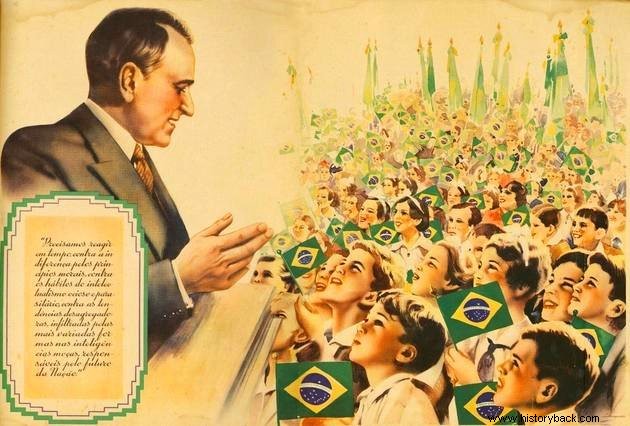
With the justification that Brazil was threatened by communism, Vargas closed Congress and declared himself president of Brazil.
Then he granted the Constitution of 1937, which concentrated even more powers on the figure of the Executive Power. He declared the political parties extinct and went on to govern with great powers.
His government had great proximity to the fascist model, despite reconciling, not without conflicts, the democratic model.
See also:Brazilian Integralist ActionEconomy
During his government, characterized by nationalism and populism, Vargas established an economic doctrine of state interference in the economy. In it, the State was the main investor and driver of the national economy.
Thus, through the application of funds for the creation of industrial infrastructure, it boosted private and state capital industries.
In addition, he established social mechanisms with the Consolidation of Labor Laws, which guaranteed a series of labor rights such as unemployment insurance and paid vacations to urban workers. It should be noted that rural workers did not benefit from these laws.
In 1938, Vargas created the IBGE (Brazilian Institute of Geography and Statistics), the Companhia Siderúrgica Nacional in 1940, Vale do Rio Doce in 1942 and the São Francisco Valley Hydroelectric Power Plant in 1945.
Foreign Relations
Foreign relations are characterized by the approximation of the United States and the progressive distance from the Axis countries, such as Germany and Italy.
This fact would culminate in the declaration and entry of Brazil into the Second World War. Likewise, it provided for the use by the Americans of the use of an air base in Natal/RN.
Personally, Vargas was against Brazilian soldiers going to the conflict, fearing that an armed and well-trained group could threaten him.
See also:Good Neighbor PolicyEnd of Estado Novo and Fall of Vargas
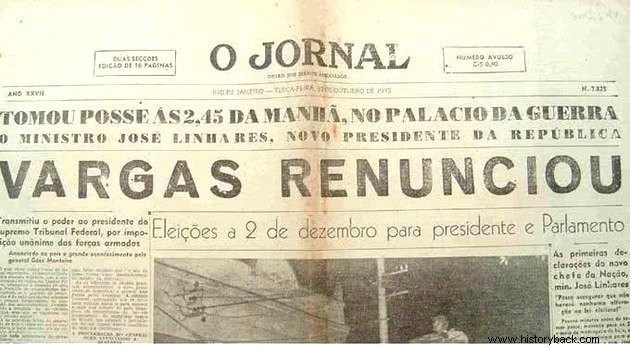
After the declaration of war on the Axis, the contradictions of the Vargas government became more explicit. Several civil and political associations began to challenge the president's political model and openly question it.
The Manifesto dos Mineiros was published where elections were openly called for, and the same was requested during the 1st Brazilian Congress of Writers.
Against this background, Vargas promulgated the Electoral Code that allowed the creation of political parties and set the presidential elections for December 2, 1945.
The military also articulated and started to conspire against the president, especially Generals Goés Monteiro (1889-1956), candidate for the UDN, and Eurico Dutra (1883-1974), candidate for the PSD.
Once again, Getúlio Vargas tries to stay in power through a political maneuver and appoints his brother as head of the Federal District Police. It was said that Benjamin Vargas (1887-1973) would arrest all generals who were against the president.
Faced with this, the military deposes Vargas, who resigns without resistance and retreats to his hometown, São Borja. However, he would not stay there for long, as he would be elected senator the following year.
Complement your study:
- New Status
- American Way of Life
- Brazil in World War II
Getúlio Vargas elected President (1950-1954)
Eurico Gaspar Dutra's government ended without major surprises.
Among the candidates for the succession, ex-president Getúlio Vargas, who was a candidate for the PTB (Brazilian Labor Party) presented himself. The victory was quite impressive, but times had changed.
Now, the world was experiencing the polarization of the Cold War and politics was well divided between those who supported the United States and the Soviet Union.
Vargas promotes a nationalist policy that involves the creation of state-owned companies such as Petrobras, but he cannot repeat the same success as the previous administration.
See also:History of PetrobrasSuicide of Getúlio Vargas
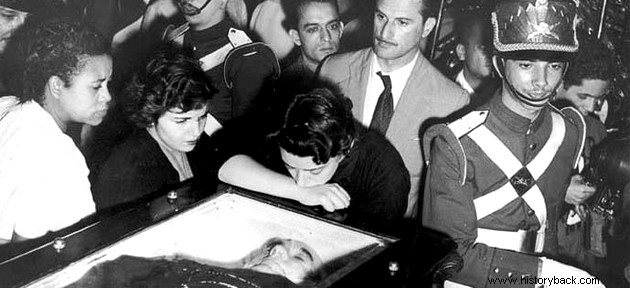
On August 5, 1954, one of Getúlio Vargas' main enemies, journalist Carlos Lacerda, was attacked in front of his house, on Torneleros Street. Lacerda would be shot and survive, but his bodyguard died on the spot.
This is followed by an investigation that points out the main mastermind of the crime as Gregório Fortunato (1900-1962), head of the president's personal guard. The opposition immediately asked for the resignation of Getúlio Vargas.
Under pressure, Vargas declared that he would only leave Catete dead and, in this way, he committed suicide in the city of Rio de Janeiro, at Palácio do Catete on August 24, 1954.
He left a will-letter where he explained the reasons for his gesture and stated:"I leave my life to enter History ".
Curiosities
- Although the Vargas government was a dictatorship, the image of Getúlio as "father of the poor" prevailed for a long time.
- One of Vargas' sons, Manuel Sarmanho Vargas and one of his grandsons, named Getúlio Dornelles Vargas Neto, would also commit suicide.
- The Vargas government coincided with the "chanchada", a popular comedy genre, in which actors such as Oscarito and Grande Otelo stood out.
Read more texts on the topic :
- Brazil Republic
- Era Vargas
- Industrialization in Brazil
- Brazilian History Questions in Enem
- Exercises on the Vargas Era
